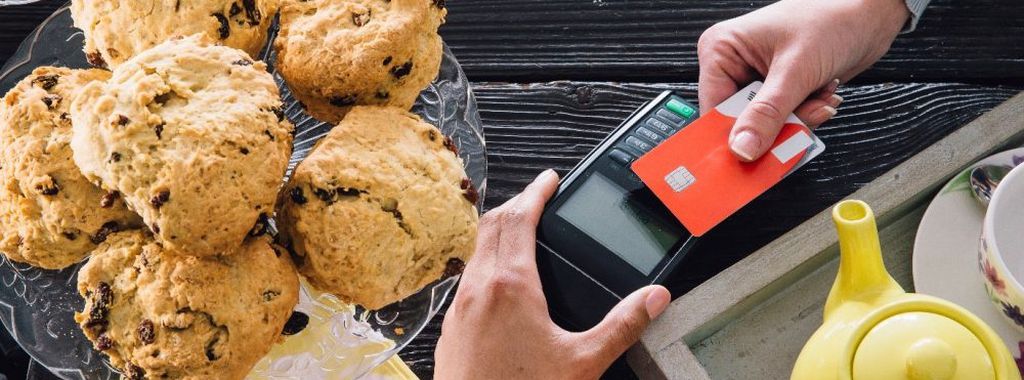2017 was the year contactless reached its tipping point and exploded as a payment method.
Figures released by UK Finance, Britain’s leading financial trade association, show contactless transactions rose by 97%. And they’re set to keep rising further still for one very simple reason:
How do Contactless payment systems work?
As contactless uses the same card processing readers and technology as Chip and PIN, it features the same levels of security and anti-fraud measures – only the customer doesn’t need to enter their PIN. They just tap the terminal to transact.
The cards themselves feature a small chip and a radio antenna that transmits signals to the terminal. It’s called radio frequency identification technology – RFID for short – and it’s this which enables a transaction.
But are you really looking to learn about the technical in and outs of contactless technology? Perhaps.
But it’s more likely that you’re here to read about:
How contactless payment systems can benefit your business
Unless you’ve been living undersea for the past 20 years (yep, contactless is already that old), you probably have a good idea of its main advantage: speed.
And given that 98% of all credit and debit cards used in Britain are contactless enabled it’s pretty likely that you’ve used contactless yourself – precisely for this reason.
Contactless transactions make even Chip and PIN seem sluggish, quickly taming even the longest queues to keep customers happy. For a Merchant, however, there are more benefits to contactless than quicker queues.
Cheaper transactions
Contactless costs less per transaction than Chip & PIN. It’s not a huge amount, but it all adds up, faster.
Guaranteed transactions
With Contactless payments, you’re guaranteed to be paid. Without dispute. And, like other card payments, contactless transactions are protected against fraud by the issuing bank.
Productivity
Transactions are faster so you can spend more time with customers or managing your business.
Less processing
You’ll spend less time counting cash, and make fewer trips to the bank (which improves security). A smaller float may also help reduce your insurance premiums.
Better receipt handling
Contactless lets you print a receipt from your card machine or your till. Whatever’s easiest.
Refunds
Enter the amount to be refunded into your EPOS, your customer taps their card, and the money’s on its way back to their account. And which customer doesn’t appreciated an easy refund?
Contactless is here to stay, further boosted by industry efforts like the New Payments Architecture and Open Banking initiatives. Every new card reader made will be contactless-ready by 2020. (You don’t need to wait that long with us: we can have a contactless card machine delivered to you in just three days.)
It’s predicted that, by 2026, British businesses will process 11 billion contactless transactions a year – a four-fold increase on 2016’s figures. And those aren’t the only changes we’ll see.
What are the different types of contactless payment methods?
Contactless has come a long way since its initial introduction as a way to help people travel more easily. In the coming years, we could see contactless appear in a number of new forms, including clothes and jewellery. That said, one format looks set to stay.
Contactless credit & debit cards
These are currently the most popular payment methods. People like the convenience of cards (they’re lighter than a pocket full of loose change) and they also offer security advantages over cash.
Smartphones & watches
Apple Pay and Google Pay are two examples of contactless on smartphones. Better still, as these methods require secondary authentication (either a passcode or fingerprint scan) they can process Higher Value transactions, meaning customers aren’t limited to a £30 limit. This opens contactless payments up to even more businesses, especially those making high-value pieces like jewellers, artisans, and artists.
Wearables
The creativity doesn’t stop there. Contactless technology can be put into pretty much
anything. Along with credit and debit cards, and smartphones, contactless has popped up in wristbands, rings and fobs – and we can expect even more diversity in the future. Don’t be surprised if someone pays one day using their own 3D-printed giraffe.
And that’s one of the advantages of contactless: it doesn’t matter whether someone pays by card or cufflink, contactless lets them do so.
Reaching the tipping point:
The phenomenal rise of contactless payments
| 2007 | 2017 |
| No. of contactless cards: 250,000 | No. of contactless cards: 111,000,000 |
| No. of contactless terminals (bank owned): 1,200 | No. of contactless terminals (bank owned):
506,110 |
| Annual transaction values: £10,000 | Annual transaction values: £4.3 billion |
| Average transaction: £4-5 | Average transaction: £9.23✮ |
| Maximum transaction value: £10 | Maximum transaction value: £30 |
Contactless quote? Contact us.
If you’re sold on the benefits of adding a contactless payment system to your business, get in touch with us for a fast, accurate quote.
We can have a contactless card reader (all set up to work right out of the box) with you in just three days.
After all, when it comes to contactless, speed is of the essence.
